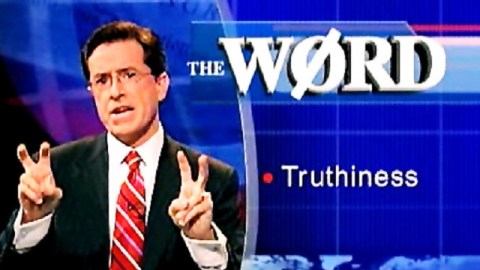Stephen Colbert and the End of “Stephen Colbert”

On October 17th, 2005, comedian Stephen Colbert introduced the persona “Stephen Colbert” on the first episode of The Colbert Report by also introducing to the world the concept of “Truthiness.” That bit (the full video’s here) not only resulted in “truthiness” becoming Merriam-Webster’s 2006 Word of the Year, but also introduced the “truthiness” of performance art to a mainstream American audience. What began as a broad caricature of a Bill O’Reilly-esque conservative TV pundit evolved over 9 years into a multidimensional character with elements of the real wit, charm, warmth, and unyielding mental sharpness of the real man. With news that Colbert will be leaving The Colbert Report at the end of 2014 to replace David Letterman as the host of the Late Show on CBS in 2015 comes great sadness on seeing “Stephen Colbert” the character come to an end, but we’ll still have the rest of the year to celebrate, appreciate, and understand what Stephen Colbert the performance artist truly accomplished.
Any fan of The Colbert Report can rattle off all their favorite bits and moments from the show’s history, so I won’t list mine here. What set that show and that character off from the rest of contemporary comedy and television (including The Daily Show, where Colbert the comedian and a proto-Colbert character both got their big break) for me more than anything was the commitment of the show and its main figure. In addition to the standard celebrities hawking their latest projects, Colbert wielded the power of his famed “Colbert Bump” to bring authors, musicians, scientists, and thinkers to his viewers that otherwise could never have found an outlet to reach a mass audience. Just like the show’s commitment to smart and funny commentary on politics and society, that commitment to bringing smart arts and sciences to his audience embodied an unspoken mission statement to use the show for public good as well as public entertainment. It reminded me of the efforts of another bespectacled comedian, Steve Allen, who brought jazz and philosophy and almost even Lenny Bruce (who waged war against the “truthiness” of the 1950s) to his audience as well as laughs.
But, even more impressive than that use of the “Colbert Bump” is Colbert’s commitment to creating and maintaining the character of “Stephen Colbert” for nine years. Lists have been compiled of the times Stephen Colbert has broken character and “played” himself. Seeing those moments you realize the delicate balance he’s maintained in creating a blowhard with a heart, someone who goes beyond caricature to a kind of sincerity that sometimes fools conservatives into thinking he’s one of their camp. The only comparable similar sustained character I can think of is Carroll O’Connor’s Archie Bunker character on the near decade run of All in the Family. Like Colbert, O’Connor captured the essence of the character so truly that he sometimes fooled the people he was lampooning into thinking he was on their side. But O’Connor never had to do the show four times a week for 40 weeks a year and had the luxury of a talented ensemble cast to share the screen, whereas Colbert flies mainly solo. When Colbert paid tribute to his mother Lorna on air after her death last June, he allegedly slipped “out of character” for some, but I respectfully disagree. That moment of openness, vulnerability, and selfless sharing of his life with his “nation” epitomized both the man and the character better than any other single moment of the show’s 9 years.
For those who fear that Stephen Colbert separated from The Colbert Report will fail to meet past standards, I hark back to the example of Steve Allen, who was the first host of The Tonight Show and essentially invented the late night talk show that Johnny Carson, Letterman, and others have reinvented in the same innovative, intellectually curious spirit started by Allen. “Stephen Colbert” of the air quotes may be no more by 2015, which may mean that Colbert could take the character places even he dared not go before as part of a final victory lap. But Stephen Colbert the performance artist will go on and craft another persona, perhaps closer to the “real” Colbert (whatever that means) but still as compelling and committed to his audience as ever. The commitment to “truthiness” will go on in some way. And that’s the word.
[Image: Still image from the “Truthiness” segment of the first episode of The Colbert Report on October 17, 2005. The full video’s available here.]





